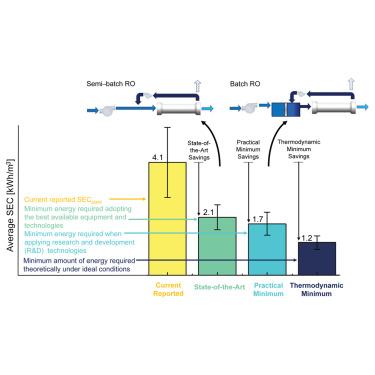Our official English website, www.x-mol.net, welcomes your
feedback! (Note: you will need to create a separate account there.)
Practical minimum energy use of seawater reverse osmosis
Joule ( IF 38.6 ) Pub Date : 2024-09-10 , DOI: 10.1016/j.joule.2024.08.005 Sultan Alnajdi , Ali Naderi Beni , Albraa A. Alsaati , Mitul Luhar , Amy E. Childress , David M. Warsinger
Joule ( IF 38.6 ) Pub Date : 2024-09-10 , DOI: 10.1016/j.joule.2024.08.005 Sultan Alnajdi , Ali Naderi Beni , Albraa A. Alsaati , Mitul Luhar , Amy E. Childress , David M. Warsinger

|
Increasing the energy efficiency in seawater reverse osmosis (SWRO) is crucial to address worsening climate change and water scarcity. This study uses data from 39 facilities and detailed modeling to identify configurations for conventional, state-of-the-art, and practical minimum energy use. Performance benchmarks for pump efficiency, membrane permeability, membrane spacer mass-transfer coefficient, and pre- and post treatment were developed. Current systems use substantially more energy than the thermodynamic least work; 69% of this excess energy can be eliminated using state-of-the-art methods, and 82% with future technologies like batch reverse osmosis (RO). Additionally, isobaric energy recovery devices (ERDs) can save significant energy in conventional designs. We also map out the impact on energy of a wide range of operating conditions, including salinity, water flux, and water recovery. The most impactful high-efficiency solutions include using batch and semi-batch configurations, using the most efficient pumps, and operating at lower flux.
中文翻译:

海水反渗透的实用最低能耗
提高海水反渗透 (SWRO) 的能源效率对于解决日益恶化的气候变化和水资源短缺问题至关重要。本研究使用来自 39 个设施和详细建模的数据来确定传统、最先进和实用的最低能源使用的配置。开发了泵效率、膜通透性、膜垫片传质系数以及预处理和后处理的性能基准。当前的系统使用的能量比热力学最小功多得多;69% 的过剩能量可以使用最先进的方法消除,82% 的能量可以通过批量反渗透 (RO) 等未来技术消除。此外,等压能量回收装置 (ERD) 可以在传统设计中节省大量能源。我们还绘制了各种操作条件对能源的影响,包括盐度、水通量和水回收率。最具影响力的高效解决方案包括使用间歇和半间歇配置,使用最高效的泵,以及以较低的通量运行。
更新日期:2024-09-10
中文翻译:

海水反渗透的实用最低能耗
提高海水反渗透 (SWRO) 的能源效率对于解决日益恶化的气候变化和水资源短缺问题至关重要。本研究使用来自 39 个设施和详细建模的数据来确定传统、最先进和实用的最低能源使用的配置。开发了泵效率、膜通透性、膜垫片传质系数以及预处理和后处理的性能基准。当前的系统使用的能量比热力学最小功多得多;69% 的过剩能量可以使用最先进的方法消除,82% 的能量可以通过批量反渗透 (RO) 等未来技术消除。此外,等压能量回收装置 (ERD) 可以在传统设计中节省大量能源。我们还绘制了各种操作条件对能源的影响,包括盐度、水通量和水回收率。最具影响力的高效解决方案包括使用间歇和半间歇配置,使用最高效的泵,以及以较低的通量运行。


















































 京公网安备 11010802027423号
京公网安备 11010802027423号